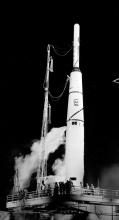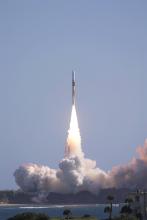Listen to today's episode of StarDate on the web the same day it airs in high-quality streaming audio without any extra ads or announcements. Choose a $8 one-month pass, or listen every day for a year for just $30.
You are here
Moon and Saturn
Finding the right parking spot is always a challenge -- especially on the Moon. For the first Apollo landing, a half century ago, NASA picked a smooth, flat, easy-to-reach site near the equator -- someplace not likely to dent the fenders.
When the astronauts of the new Artemis program reach the Moon, the parking will be a lot more complicated. NASA’s looking at sites near the south pole. Such sites are trickier to reach, they’re more rugged, and many of them aren’t always in view of tracking stations.
But they’re a lot more interesting. Deposits of water ice may lurk at the bottoms of craters that never see the Sun. And the sites are inside the Moon’s largest impact basin, so astronauts can explore many layers of rock, which record much of the Moon’s history.
Mission planners have to take many factors into account as they ponder the landing sites. A site has to offer a big landing zone, plenty of sunlight, safe slopes, and interesting targets for study.
Science teams have identified more than a dozen sites that meet those criteria. The list includes the rims of several craters that might have ice in their dark recesses. The teams have even mapped routes for astronauts to explore -- at challenging parking spots near the south pole.
The Moon climbs into view by midnight tonight. The planet Saturn looks like a bright star well to its left. They’ll be closer tomorrow night, with Saturn rising above the Moon.
Script by Damond Benningfield





